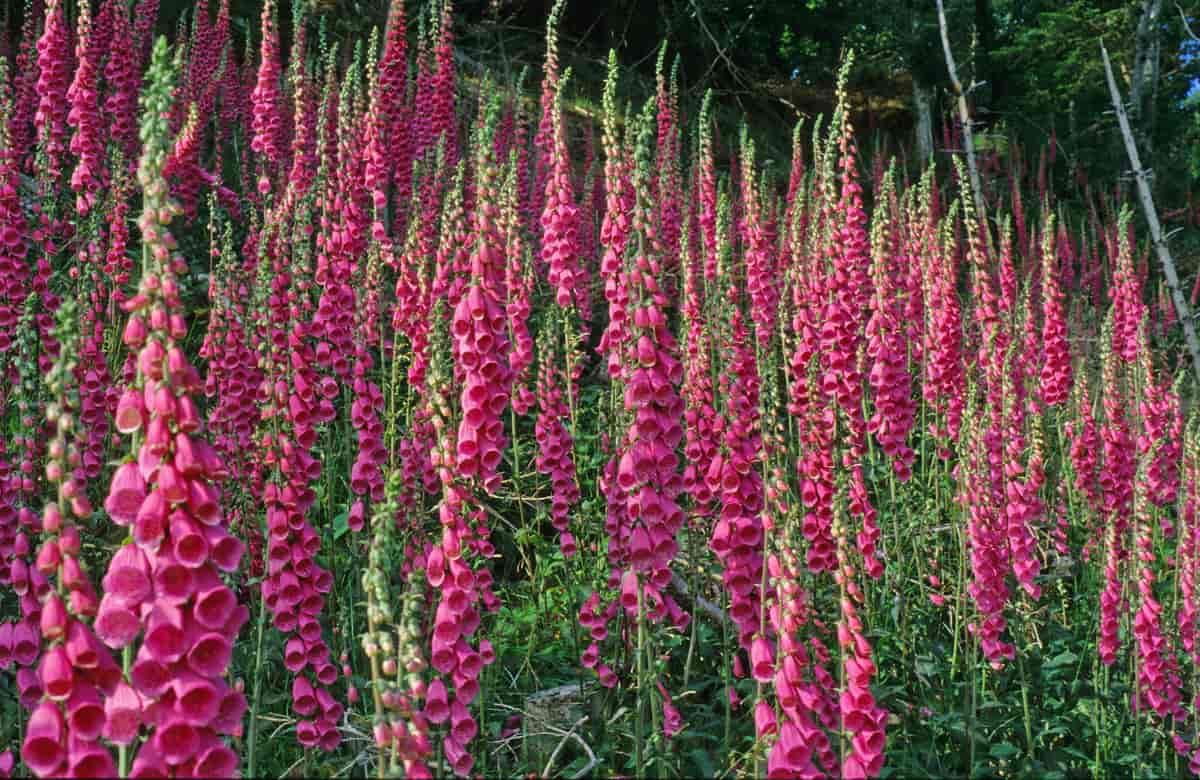Foxglove digitalis, also known as fairy’s gloves or witches’ gloves, is a captivating flowering plant that graces gardens worldwide. Its tall, majestic stalks adorned with delicate, bell-shaped flowers come in a spectrum of colors, adding a touch of whimsical charm to any landscape. However, beneath this alluring exterior lies a hidden secret – all parts of the foxglove digitalis plant are laced with potent toxins. This article delves into the fascinating world of fairy’s gloves, exploring its captivating beauty, its deceptive danger, and its intriguing role in the history of medicine.

Table of Contents
- The Allure of the Foxglove
- The Deceptive Threat: The Toxicity of Foxglove Digitalis
- Living with Foxgloves: Safety and Enjoyment in the Garden
- Conclusion: A Respectful Dance with Duality
- FAQs: Unveiling the Mysteries of Foxglove Digitalis
The Allure of the Foxglove
The foxglove (Digitalis purpurea) is a captivating genus of flowering plants native to Europe, Western Asia, and northwestern Africa. These herbaceous perennials, shrubs, and biennials boast a long history of gracing gardens with their tall, elegant spires adorned with vibrantly colored blooms. Beyond their undeniable beauty, foxgloves hold a place in folklore and mythology, often associated with fairies and the unseen realm due to their delicate form and preference for shady woodlands.

A Botanical Look at the Foxglove
Foxgloves come in a variety of species, each with its own unique charm. The common foxglove (Digitalis purpurea) is the most well-known, featuring tubular-shaped flowers in shades of purple, pink, and white. These blossoms often have speckled or spotted interiors, adding an intriguing detail to their delicate beauty. The flowers gracefully droop from the central stalk, forming a cascading display that adds a touch of elegance to any garden border.
A Feast for the Eyes: The Enchantment of Foxglove Flowers
Beyond their captivating colors, fairy’s gloves flowers possess a unique charm that has captivated gardeners for centuries. The blossoms boast a speckled or spotted interior, adding an intriguing detail to their delicate beauty. These speckles often come in contrasting colors, creating a mesmerizing visual dance within each flower. Furthermore, the blooms tend to droop gracefully from the central stalk, forming a cascading display that adds a touch of elegance to any garden border.
Beyond the Garden: The Fairy’s Gloves in Folklore and Culture
The captivating nature of foxglove digitalis has transcended the garden, weaving its way into the rich tapestry of folklore and culture. In Celtic mythology, the plant was associated with fairies, believed to be used as tiny thimbles or gloves by these otherworldly creatures. This association with the unseen realm likely stemmed from the foxglove’s delicate form and its preference for shady, somewhat mystical woodlands. On the other hand, some cultures associated foxglove with witchcraft, fearing its potent toxins and using it symbolically in rituals. The plant’s name itself, “digitalis,” is derived from the Latin word “digitus,” meaning finger, likely referencing the resemblance of the flowers to fingertips encased in gloves.
The Deceptive Threat: The Toxicity of Fairy’s Gloves
While undeniably beautiful, foxglove harbors a hidden danger – all parts of the plant, from the roots to the flowers, contain potent toxins known as cardiac glycosides. These complex molecules can disrupt the heart’s normal rhythm if ingested, potentially leading to serious health complications. The deceptive nature of this toxicity lies in the fact that the foxglove digitalis plant itself appears harmless. Its delicate flowers and velvety leaves don’t give away the potent arsenal it holds within. This is why it’s crucial to be aware of the dangers associated with foxglove, especially in households with curious children or pets.
A Chemical Arsenal: Cardiac Glycosides and Their Impact
Cardiac glycosides, the culprits behind foxglove digitalis’ toxicity, are a group of chemicals that specifically target the heart muscle. These complex molecules interfere with the heart’s natural electrical impulses, disrupting its ability to pump blood efficiently. Symptoms of foxglove digitalis poisoning can range from mild nausea and vomiting to more serious complications like irregular heartbeat, dizziness, and even cardiac arrest in severe cases. The severity of the poisoning depends on the amount of plant material ingested.
It’s important to remember that foxglove digitalis is not meant to be a DIY medication. While its potential benefits in regulating heart function have been explored in medicine (as we’ll discuss later), ingesting any part of the plant can be extremely dangerous and should never be attempted without professional guidance.
A Historical Misstep: The Perils of Unregulated Herbal Remedies
The history of medicine is littered with fascinating, and sometimes dangerous, attempts to harness the power of plants. Foxglove digitalis is no exception. For centuries, various cultures used different parts of the plant to treat a variety of ailments, including heart conditions, dropsy (fluid buildup in the body), and even epilepsy. However, these applications were often based on folklore and anecdotal evidence rather than a deep understanding of the plant’s complex chemistry. The lack of standardized dosing and the unpredictable nature of the toxins in foxglove digitalis often led to more harm than good.
This historical use of foxglove digitalis highlights the importance of scientific research and controlled trials in developing safe and effective medications. Thankfully, modern medicine has taken a more sophisticated approach to utilizing the potential benefits of foxglove digitalis.
Separating Fact from Fiction: Foxglove Digitalis and Modern Medicine
The story of fairy gloves and medicine doesn’t end with the perils of unregulated herbal remedies. In the 18th century, a groundbreaking discovery paved the way for a safer and more controlled use of the plant’s potential. A British physician named William Withering observed the positive effects of foxglove tea on patients suffering from heart failure. Through careful observation and experimentation, he established a standardized method for preparing and administering the foxglove extract. This marked a turning point in the use of foxglove digitalis, laying the foundation for the development of digoxin, a modern medication used to regulate heart rhythm.
However, it’s crucial to understand that digoxin is a prescription medication with potential side effects. It’s only used under the close supervision of a doctor and requires regular monitoring. Foxglove digitalis itself should never be considered a substitute for digoxin or any other prescribed medication.

Living with Foxgloves: Safety and Enjoyment in the Garden
The captivating beauty of foxglove shouldn’t deter you from including it in your garden. However, with its deceptive toxicity, it’s essential to prioritize safety while appreciating its charm. Here are some key points to remember:
Cautious Companions: Safe Handling Practices for Foxglove Digitalis
- Glove Up: Always wear gloves when handling any part of the foxglove digitalis plant, from planting to pruning. This simple precaution helps prevent accidental ingestion of toxins through skin contact.
- Mind Your Distance: Plant foxglove digitalis in areas with minimal foot traffic, especially if you have young children or pets. Keeping them a safe distance from the plant reduces the risk of them ingesting any part of it.
- Clean Up Thoroughly: After handling foxglove digitalis, wash your hands thoroughly with soap and water. This removes any residual toxins that might have transferred to your skin.
- Educate Your Family: If you have children, talk to them about the dangers of foxglove digitalis and explain why they should never touch or eat any part of the plant.
By following these simple safety measures, you can enjoy the beauty of foxglove digitalis in your garden without compromising the well-being of yourself or your loved ones.
Blooming Alternatives: Non-Toxic Lookalikes for Your Garden
For those who might prefer a safer option but still crave the visual allure of foxglove digitalis, there are several non-toxic lookalikes that can add a similar touch of elegance to your garden. Here are a few captivating alternatives to consider:
- Canterbury Bells (Campanula medium): These charming plants boast clusters of bell-shaped flowers in a variety of colors, much like foxglove digitalis. However, unlike its toxic counterpart, Canterbury bells are completely safe for children and pets. They come in a range of heights, making them suitable for various garden borders.
- Bee Balm (Monarda didyma): This vibrant plant attracts pollinators like bees and butterflies with its clusters of colorful, tubular flowers. Bee balm thrives in full sun and offers a delightful fragrance that complements its visual appeal. The foliage also possesses a refreshing lemon scent when brushed against.
- Foxglove Beardtongue (Penstemon digitalis): Despite its name, this plant is not related to true foxglove digitalis and is entirely non-toxic. Foxglove beardtongue offers a similar tall, spiky structure with clusters of tubular flowers in various colors, including purple, pink, and white. It’s a low-maintenance option that adds a touch of vertical interest to your garden.
These are just a few examples, and with a little research, you can discover a variety of non-toxic flowering plants that offer a safe and beautiful alternative to foxglove digitalis.
Spreading Awareness: Educating Others about the Risks of Foxglove Digitalis
While foxglove digitalis can be a captivating addition to a garden, it’s crucial to spread awareness about its potential dangers. Here are some ways you can contribute:
- Label Your Plants: Clearly label your foxglove digitalis plants with a botanical name and a warning about their toxicity. This helps educate others, especially children, who might not be familiar with the plant.
- Share Your Knowledge: Talk to your friends and neighbors about the beauty and dangers of foxglove digitalis. Educating others can help prevent accidental poisonings.
- Support Educational Initiatives: Consider supporting organizations or initiatives that promote safe gardening practices and educate the public about potentially toxic plants.
By taking these steps, you can help create a more informed and responsible gardening community.
Conclusion: A Respectful Dance with Duality
Foxglove digitalis embodies a fascinating duality – a captivating beauty intertwined with a hidden danger. Its delicate flowers grace gardens worldwide, while its potent toxins serve as a reminder of the power and complexity of the natural world. Respecting this duality is key to appreciating foxglove digitalis safely. By following proper safety guidelines and educating others about its potential risks, we can ensure that this captivating plant continues to grace our gardens without posing a threat.
FAQs: Unveiling the Mysteries of Foxglove Digitalis
Here are some frequently asked questions about foxglove digitalis:
1. Can I grow foxglove in my garden?
Yes, you can grow fairy gloves in your garden, but it’s crucial to prioritize safety. Follow the safe handling practices mentioned earlier and plant it in areas with minimal foot traffic, especially if you have children or pets.
2. What are the symptoms of foxglove digitalis poisoning?
Symptoms can range from mild nausea and vomiting to more serious complications like irregular heartbeat, dizziness, and even cardiac arrest. If you suspect someone has ingested fairy gloves, seek immediate medical attention.
3. Is digoxin the same as foxglove?
No, digoxin is a medication derived from foxglove digitalis but in a controlled and purified form. It’s a prescription medication used to regulate heart rhythm and should only be taken under a doctor’s supervision.
4. Are there any benefits to foxglove digitalis?
The discovery of digoxin, derived from witches’ gloves, has provided a valuable tool in modern medicine for managing heart conditions. However, this doesn’t mean handling the plant itself is advisable.
5. What are some good substitutes for foxglove in my garden?
Several non-toxic plants offer similar visual appeal, such as Canterbury bells, bee balm, and foxglove beardtongue. These alternatives provide a safe and beautiful way to add a touch of floral charm to your garden.
By understanding the captivating beauty and potential dangers of witches’ gloves, we can cultivate a respectful relationship with this intriguing plant.